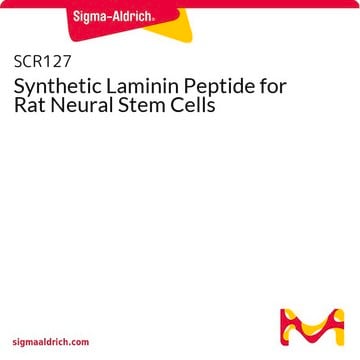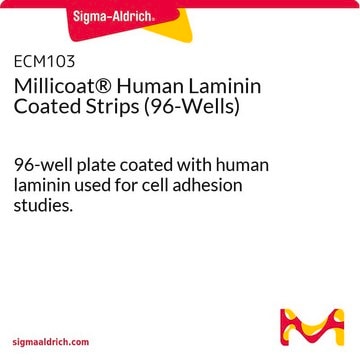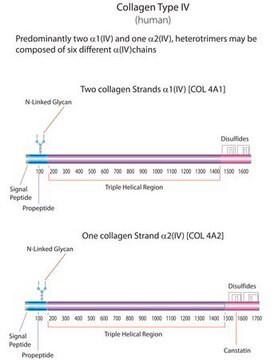AG56P
Human Laminin (pepsinized) Purified Protein
Synonym(s):
Laminin 1, Laminin 2, Laminin 3, Laminin 6, Laminin 8, Laminin 10
About This Item
Recommended Products
biological source
human
Quality Level
Assay
≥95% (SDS-PAGE)
form
liquid
manufacturer/tradename
Chemicon®
concentration
0.25 mg/mL
technique(s)
cell culture | mammalian: suitable
input
sample type pancreatic stem cell(s)
sample type neural stem cell(s)
sample type hematopoietic stem cell(s)
sample type induced pluripotent stem cell(s)
sample type epithelial cells
sample type: human embryonic stem cell(s)
sample type mesenchymal stem cell(s)
NCBI accession no.
UniProt accession no.
shipped in
dry ice
storage temp.
−20°C
−70°C
Gene Information
human ... LAMB1(3912)
Related Categories
General description
Preparation: Chemicon′s purified human laminin is prepared from freshly frozen human placenta tissue that is homogenized in PBS with a blender and the mixture centrifuged. The pellet is then washed with 0.5M acetic acid, collected and subjected to and extended Pepsin A digestion. The pepsin digest is neutralized, centrifuged to clear debris, and applied to an antibody column containing mouse anti-human laminin monoclonal 4E10 monoclonal antibody {MAB1921}. The solubilized laminin solution is passed over the column, and utlimately the laminin is released via acidification with KSCN. Then the material is dialyzed against PBS. The antibody 4E10 is specific for laminin beta1 chain. This chain is found in Laminin′s 1,2,3,6,8,10 under the native conditions used to purify the material.
Quality
Physical form
Preparation Note
Storage and Stability
During shipment, small volumes of product will occasionally become entrapped in the seal of the product vial. For products with volumes of 200μL or less, we recommend gently tapping the vial on a hard surface or briefly centrifuging the vial in a table-top centrifuge to dislodge any liquid in the container′s cap.
Legal Information
Disclaimer
Storage Class Code
12 - Non Combustible Liquids
WGK
WGK 2
Flash Point(F)
Not applicable
Flash Point(C)
Not applicable
Certificates of Analysis (COA)
Search for Certificates of Analysis (COA) by entering the products Lot/Batch Number. Lot and Batch Numbers can be found on a product’s label following the words ‘Lot’ or ‘Batch’.
Already Own This Product?
Find documentation for the products that you have recently purchased in the Document Library.
Customers Also Viewed
Protocols
Coating surfaces with laminin for culturing cells requires specific conditions for optimal results. Protocols for coating coverslips to culture neurospheres and general cell culture are included.
This page covers the ECM coating protocols developed for four types of ECMs on Millicell®-CM inserts, Collagen Type 1, Fibronectin, Laminin, and Matrigel.
Our team of scientists has experience in all areas of research including Life Science, Material Science, Chemical Synthesis, Chromatography, Analytical and many others.
Contact Technical Service














